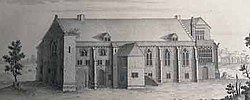Bradenstoke Priory
| Bradenstoke Priory | |
|
Wiltshire | |
|---|---|
 18th-century engraving of the Priory by Samuel and Nathaniel Buck | |
| Location | |
| Location: | 51°30’44"N, 2°0’13"W |
| Order: | Augustinian |
| History | |
| Established: | 1142 |
| Founder: | Walter FitzEdward de Salisbury |
| Dedication: | St Mary |
| Disestablished: | 1539 |
| Information | |
| Remains: | Tower and undercroft |
Bradenstoke Priory is a mediæval priory in the village of Bradenstoke, Wiltshire. It is noted today for some of its structures having been used by William Randolph Hearst for the renovation of St Donat's Castle, near Llantwit Major, Glamorgan, in the 1930s.
Foundation to the Dissolution
The priory was founded in 1142 as the Augustinian priory of Clack, and dedicated to Saint Mary.[1] It was well-sited on a high ridge near a holy well, with further springs nearby; there is some evidence that a chapel of the era of Henry I already existed at the holy well.[1]
The founder,[2] Walter FitzEdward de Salisbury, was the son of Edward de Salisbury,[3] a High Sheriff of Wiltshire; he gave lands for a priory as a daughter house of St Mary's Abbey, Cirencester, according to its charter, "to serve God forever!".[4] After the death of his wife, he "took the tonsure and habit of the canons" and on his death in 1147, was buried in the Priory, near the choir.[4] His descendants, the Earls of Salisbury remained closely connected with the priory for many years.[1] In 1190 thirteen of the monks migrated to Cartmel Priory, Lancashire, which had been recently established by William Marshal.[5]
Throughout most of its early history, the priory also enjoyed royal support, being granted a charter by Henry II some time between 1173 and 1179; Richard I also lent assistance for the priory to break away from the abbot of Cirencester to become a priory in its own right, and King John, a frequent visitor, intervened to confirm this secession.[1] This tradition continued with the grant of royal protection by Henry III, who visited in 1235.[1]


By the 14th century Bradenstoke Priory had gained wealth and lands in nine counties besides Wiltshire.[6] The priory was dissolved on 17 January 1539 at the Dissolution of the Monasteries;[1] at about this time, its total income was £270 10s 8d.[7] It then passed from The Crown to a Richard Pexel (or Pecsall) and his heirs sold it to the Methuen family of Corsham.[8]
John Aubrey described the priory as "Very well built, with good strong ribs", and having a cellar "the stateliest in Wiltshire".[1] But he added "the very [sic] of this fair church are now, 1666, digged up, where I saw severall freestone coffins ... and severall capitalls and bases of handsome Gothique pillars. On the west end of the hall was the King's lodgeings, which they say were very noble, and standing about 1588."[9]
A grange farm at Lower Seagry, near Christian Malford, had been associated with the priory.[10]
Modern history

In 1925 William Randolph Hearst had seen St Donat's Castle advertised for sale in Country Life magazine and cabled his agent to buy it.[11] He also bought and removed the guest house, Prior's lodging, and great tithe barn of Bradenstoke Priory; of these, some of the materials became a banqueting hall, complete with a sixteenth-century French chimneypiece and windows; also used were a fireplace dated to c. 1514 and a fourteenth-century roof,[1][11] which became part of the Bradenstoke Hall, despite this use being questioned in Parliament.[12] The tithe barn was crated and sent to Hearst Castle, San Simeon, California, and sold again when Hearst lost interest.[13] The crates with the barn stones are stored in a warehouse of Alex Madonna Construction of San Luis Obispo.[14]
All that remains of the priory in the 21st century are its tower and undercroft, the latter being identified by English Heritage in its 1996–97 programme as being at risk and requiring emergency remedial works.[15] It was announced in 2005 that DEFRA would be financing a plan to preserve the orchard and landscape around the remains.[16]
References
- ↑ 1.0 1.1 1.2 1.3 1.4 1.5 1.6 1.7 Pugh, R.B., ed (1956). "Houses of Augustinian canons: Priory of Bradenstoke". A History of the County of Wiltshire. Victoria County History. 3. pp. 275–288. http://www.british-history.ac.uk/report.aspx?compid=36538. Retrieved 14 March 2009.
- ↑ Bowles, M.A., M.R.S.L.; Rev. W. L.; Nichols; John Gough, Annals and Antiquities of Lacock Abbey (25 Parliament Street; London, England: John Bowyer Nichols and Son, 1835), pg 20 [1]
- ↑ Foundation for Medieval Genealogy, Medieval Lands Project, online \\fmg.ac/Projects/MedLands\\, England, Earls Created 1138-1143 (EN2) v3.1; Salisbury, Earls of Salisbury 1143-1261 (de Salisbury) (Chap 11A); Edward de Salisbury [2]
- ↑ 4.0 4.1 Bowles, William Lisle (1838). Annals and antiquities of Lacock Abbey. http://www.wiltshire.gov.uk/community/gettextimage.php?book_no=010&chapter_no=03&page_no=0008&dir=next. Retrieved 2009-03-28.
- ↑ "English Priories – Cartmel Priory". The Heritage Trail. http://www.theheritagetrail.co.uk/priories/cartmel_priory.htm. Retrieved 2009-03-21.
- ↑ London, Vera C.M. (1979). The Cartulary of Bradenstoke Priory. 35. Devizes: Wiltshire Record Society. includes abstracts of two cartularies in the British Library
- ↑ Bowles, William Lisle (1838). Annals and antiquities of Lacock Abbey. p. 31. http://www.wiltshire.gov.uk/community/gettextimage.php?book_no=010&chapter_no=03&page_no=0013. Retrieved 2009-03-24.
- ↑ Bowles, William Lisle (1838). Annals and antiquities of Lacock Abbey. p. 32. http://www.wiltshire.gov.uk/community/gettextimage.php?book_no=010&chapter_no=03&page_no=0014&dir=next. Retrieved 2009-03-24.
- ↑ Aubrey, John (2008). The Natural History of Wiltshire. BiblioBazaar. ISBN 978-1-4346-6761-8. https://books.google.com/books?id=tfcFnKPZBXsC&pg=PA209&lpg=PA209&dq=%22Bradenstoke+Priory%22&source=bl&ots=EEwiSb9EvY&sig=W10rhgfMjXiS8SokBM5_HjcW0Ks&hl=en&ei=GIrOSbLBH5SqjAfVvaDoCQ&sa=X&oi=book_result&resnum=3&ct=result#PPA209,M1. Retrieved 2009-03-28.
- ↑ "Wiltshire and Swindon Sites and Monument Record Information". http://history.wiltshire.gov.uk/smr/getsmr.php?id=5424. Retrieved 2009-01-23.
- ↑ 11.0 11.1 Harris, John (2007). Moving Rooms :. Yale University Press. pp. 84–86. ISBN 978-0-300-12420-0. https://books.google.com/books?id=nwWH3KSt7s4C&pg=PA85&lpg=PA85&dq=%22St+Donat%27s+Castle%22+Bradenstoke&source=web&ots=R89VKkX14_&sig=LuvBAvyIYSa4k6nLSPUMqXKILP4&hl=en&sa=X&oi=book_result&resnum=7&ct=result#PPA84,M1.
- ↑ "A DESCRIPTION OF THE CASTLE AND GARDENS". http://www.stradling.org.uk/docs/Guide1.htm. Retrieved 2009-01-23.
- ↑ "Bradenstoke Priory". Burton Bradstock Online. http://www.burtonbradstock.org.uk/History/Bradenstoke%20Priory_files/Bradenstoke%20Priory.htm. Retrieved 2009-01-23.
- ↑ "rootingforancestors". http://rootingforancestors.blogspot.de/2009/07/blog-post.html. Retrieved 2016-01-24.
- ↑ "Archaeology Review 1996 – 97 : 4.19 Publications". English Heritage. http://www.eng-h.gov.uk/ArchRev/rev97_8/cas3.htm. Retrieved 2009-03-28.
- ↑ "Historic site set to be restored". archive.thisiswiltshire.co.uk. http://archive.thisiswiltshire.co.uk/2005/7/1/83117.html. Retrieved 2010-10-10.